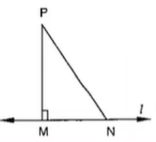OA and OB are fixed straight lines, P is any point and PM and PN are the perpendiculars from P on OAandOB, respectively. Find the locus of P if the quadrilateral OMPN is of constant area.
Taking OA as the x-axis, O as the origin, let the equation of OB be y = mx.
Then
M≡(x1,0)
The equation of hte perpendicular PN is
my+x=my1+x1
Solving the equations of OB and PN, we get
N≡(my1+x11+m2,m(my1+x1)1+x2)
∴ Area of quadrilateral OMPN (by stair method)
=12∣∣
∣
∣
∣
∣
∣∣00x10x1y1(my1+x1)/(1+x2)m(my1+x1)/(1+m2)00∣∣
∣
∣
∣
∣
∣∣
[12x1y1+x1m(my1+x1)1+x2−y1my1+x11+m2]
=±k(say)
Therefore, the locus P is
mx2+2m2xy−my2±2(1+m2)k=0
Here, h=x2
a = m
b=−m
f=g=0
and c=±2(1+m2)k
∴ Δ=abc+2fgh−af2−bg2−ch2
=±2m2(1+m2)k±2m4(1+m2)k2≠0
and h2>ab
So, the locus is a hyperbola.

Topper's Solved these Questions
- HYPERBOLABook:CENGAGEChapter:HYPERBOLAExercise:Exercise 7.2
Explore 12 Videos
- HYPERBOLABook:CENGAGEChapter:HYPERBOLAExercise:Exercise 7.3
Explore 10 Videos
- HYPERBOLABook:CENGAGEChapter:HYPERBOLAExercise:JEE Advanced Previous Year
Explore 14 Videos
- HIGHT AND DISTANCE Book:CENGAGEChapter:HIGHT AND DISTANCE Exercise:JEE Previous Year
Explore 3 Videos
- INDEFINITE INTEGRATIONBook:CENGAGEChapter:INDEFINITE INTEGRATIONExercise:Question Bank
Explore 25 Videos
Similar Questions
OPQR is a square and M,N are the middle points of the sides PQandQR , respectively. Then the ratio of the area of the square to that of triangle OMN is 4:1 (b) 2:1 (c) 8:3 (d) 7:3
View SolutionIn fig. 28.7 if the coordinates of point P are (a,b,c) then Write the coordinates of points A, B, C, D, E and F. Write the coordinates of the feet of the perpendiculars from the point P to the coordinate axes. Write the coordinates of the feet of the perpendicular from the point P on the coordinate planes XY, YZ and ZX. Find the perpendicular distances of point P from XY,YZ and ZX− planes. Find the perpendicular distances of the point P fro the coordinate axes. Find the coordinates of the reflection of P are (a,b,c) . Therefore OA=a, OB=b nd OC=⋅
View Solution
Knowledge Check
The number of P-O-P bonds present in P4O6andP4O10 are respectively
A5,5B5,6C6,6D6,5If MO is the mass of an oxygen isotope 8O17,MpandMn are the masses of a proton and a neutron, respectively, the nuclear binding energy of the isotope is
A(MO−8Mp)c2B(MO−8Mp−9Mn)c2CMOc2D(MO−17Mn)c2If MO is the mass of an oxygen is otpe _(8)O17,MpandMN are the mases of a proton and a neutron respectively , the nuclear binding energy of the isotope is
AMOC2B(MO−17Mn)c2C(MO−8Mp)c2D(8MP+9Mn−MO)c2
The line x+y=p meets the x- and y-axes at AandB , respectively. A triangle APQ is inscribed in triangle OAB,O being the origin, with right angle at Q.P and Q lie, respectively, on OBandAB . If the area of triangle APQ is 38th of the are of triangle OAB, the AQBQ is equal to (a)2(b) 23 (c) 13 (d)3
View SolutionTwo tangents PAandPB are drawn from an external point P to a circle with centre O. Prove that AOBP is a cyclic quadrilateral.
View SolutionM is the son of N. O is the father of N. P is the father of M. How is N related to P?
View SolutionOPQR is a square and M,N are the midpoints of the sides PQ and QR , respectively. If the ratio of the area of the square to that of triangle OMN is λ:6, then λ4 is equal to 2 (b) 4 (c) 2 (d) 16
View SolutionOf all the line segments that can be drawn to a given line, from a point, not lying on it, the perpendicular line segment is the shortest. GIVEN : A straight line l and a point P not lying on l. PM⊥l and N is any point on 1 other than M. TO PROVE : PM<PN

View Solution
